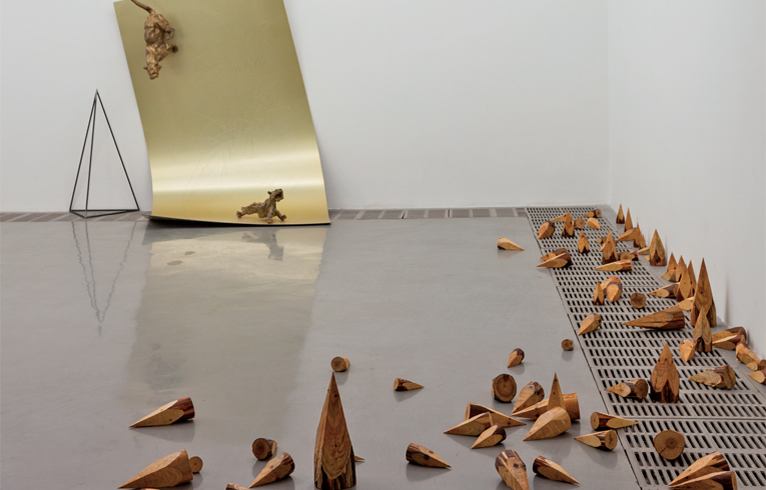YANG XINGUANG: VIOLENCE WITHOUT MERCY
| October 30, 2012 | Post In LEAP 16

In line with the sculptor and installation artist Yang Xinguang’s predilection for referencing classical Chinese, the title of his third solo exhibition at Boers-Li originates in an excerpt from Journey to the West: “As the saying goes, the warrior avoids unnecessary combat; but once I start there’ll be no mercy.” Indeed, the works scattered throughout the gallery possess all the air of violence: sharp, calculated, and emitting a sense of irremediable finality. For whatever reason, Yang seems to have reached a boiling point, and his practice has come to set the object aside, privileging allusion over form.
Wood has long been Yang Xinguang’s material of choice, and Sharp Point 3— 315 chunks of wood whittled into sharp conical points that diffuse outwards from the first gallery wall— correctly suggests that this preference has not changed. However, their sheer proliferation indicates that his work is no longer contingent to object-based aesthetics alone; here it is buttressed by the violent implications of their militant potential. Even so, one is compelled by the urge to touch their beautiful, razor-sharp extremities. Yang seems to communicate that we are never entirely capable of avoiding death and destruction— amidst the flawless perfection of the cosmos, danger lurks, part and parcel of our existence.
In a rare instance of figural representation, Yang Xinguang reinforces this elemental truth in Two Tigers. A pair of bronze tigers cast back when Yang was still a student— perhaps a time when, before his craft-heavy methodology fully set in, the artist’s concerns were still tied to iconography; in this case, that of Chinese culture— race down a slope of aluminum sheeting, apparently in the midst of a fight. Before wondering what would cause one to clash with one’s own kin, the viewer is caught by the qualitative contrast between the smooth sheeting and the rough-hewn animals; but the fact that the precision-made industrial aluminum has been warped and defaced by the struggle steers the viewer’s thoughts back, suggesting again that everything is inevitably subject to Mother Nature’s indomitable forces— when elephants fight, it is the grass that suffers. The realization strikes a chord in the viewer, and these inanimate objects become a source of pity.
A similar transcendence of form, and audience interaction, is sought in The Portrait of two stupid men (the Chinese title refers to the protagonists of Dumb and Dumber): two “worthless trees that narrowly escaped the chop of the axe.” The work is perhaps a criticism of Zhuangzi, who in witnessing a woodcutter decide against felling one particular tree, proclaimed that having no use to others may prove to be of great use to the self. Yes, these trees held no value for the lumberjack, but they were only left untouched after being uprooted; Yang discovered them abandoned on the roadside, and with his knife brutally exaggerated their “good fortune”— the uselessness of their uselessness— to a graceful polish. Yang proclaims to have offered these two trees an “extension on life,” but converting them to marketable art— what sad kind of life is this? Again, Yang constructs affect: the viewer is confronted with the urge to touch these “stupid men,” not due to their material or aesthetic allure, but in a show of empathy.
In middle of the space is Circle, a horizontal queue of flat, round panels of wood painted nearly the same white as the wall on which they hang. Visually, they seem to float on the wall, and at this point, the viewer may begin to imagine them as portals to a dimension less fraught and more forgiving than our own. Upon closer inspection, however, the perimeter of each is saw-toothed, menacing, painted a dense black. While our eyes gravitate towards the white, impeccable circles, the truth reveals their dark, imperfect edges. Both pertain to the mathematical precision of the universe, the probability of improbability.
Overseeing all this from the second floor, unique and alone, is Mountain Rocks 2— a small forest woven out of wire resting on a bed of acrylic “snow” that itself covers a slab of pink granite. Aesthetically and formally, the piece echoes There Are Stones Below (2011). With respect to the narrative structure of “Violence without Mercy,” however, it is the pièce de résistance, a powerful microcosm of Yang Xinguang’s newly re-codified world, pregnant with interpretive possibility.
Einar Engström

